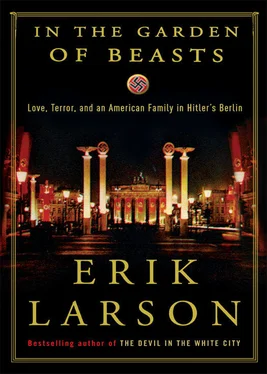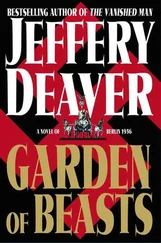Schultz and Martha chatted at first about innocuous things, but soon the conversation turned to the rapid transformation of Berlin during the six months since Hitler had become chancellor. Schultz told stories of violence against Jews, communists, and anyone the Nazis saw as unsympathetic to their revolution. In some cases the victims had been American citizens.
Martha countered that Germany was in the midst of a historic rebirth. Those incidents that did occur surely were only inadvertent expressions of the wild enthusiasm that had gripped the country. In the few days since her arrival Martha had seen nothing at all to corroborate Schultz’s tales.
But Schultz pressed on with stories of beatings and capricious imprisonments in the “wild” camps—ad hoc prisons that had sprung up throughout the country under the control of Nazi paramilitary forces—and in more formal prisons, known by now as concentration camps. The German word was Konzentrationslager , or KZ. The opening of one such camp had occurred on March 22, 1933, its existence revealed at a press conference held by a thirty-two-year-old former chicken farmer turned commander of the Munich police, Heinrich Himmler. The camp occupied an old munitions factory a brief train ride from Munich, just outside the charming village of Dachau, and now housed hundreds of prisoners, possibly thousands—no one knew—most arrested not on specific charges but rather for “protective custody.” These were not Jews, not yet, but communists and members of the liberal Social Democratic Party, all held in conditions of strict discipline.
Martha grew annoyed at Schultz’s effort to tarnish her rosy view, but she liked Schultz and saw that she would make a valuable friend, given her vast range of contacts among journalists and diplomats. They parted amicably, but with Martha unshaken in her view that the revolution unfolding around her was a heroic episode that could yield a new and healthy Germany.
“I didn’t believe all her stories,” Martha wrote later. “I thought she was exaggerating and a bit hysterical.”
When Martha left her hotel she witnessed no violence, saw no one cowering in fear, felt no oppression. The city was a delight. What Goebbels condemned she adored. A short walk from the hotel, to the right, away from the cool green of the Tiergarten, took her to Potsdamer Platz, one of the busiest intersections in the world, with its famous five-way streetlight, believed to have been the first-ever stoplight installed in Europe. Berlin had only 120,000 cars, but at any given moment all of them seemed to collect here, like bees to a hive. One could watch the whirl of cars and people from an outdoor table at the Josty Café. Here too stood Haus Vaterland, a five-story nightclub capable of serving six thousand diners in twelve restaurant milieus, including a Wild West bar, with waiters in immense cowboy hats, and the Rhineland Wine Terrace, where each hour guests experienced a brief indoor thunderstorm complete with lightning, thunder, and, to the chagrin of women wearing true silk, a sprinkling of rain. “What a youthful, carefree, won’t-go-home-till-morning, romantic, wonderful place!” one visitor wrote: “It is the jolliest place in Berlin.”
For a twenty-four-year-old woman unencumbered by job and financial concern and soon to be freed of a dead marriage, Berlin was endlessly compelling. Within days she found herself going on an afternoon “tea date” with a famous American correspondent, H. R. Knickerbocker—“Knick” to his friends—who filed stories for the New York Evening Post . He took her to the Eden Hotel, the notorious Eden, where communist firebrand Rosa Luxemburg had been beaten nearly to death in 1919 before being driven into the adjacent Tiergarten and killed.
Now, in the Eden’s tea room, Martha and Knick danced. He was skinny and short, with red hair and brown eyes, and led her across the floor with skill and grace. Inevitably, the conversation shifted to Germany. Like Sigrid Schultz, Knickerbocker tried to teach Martha a bit about the politics of the country and the character of its new leadership. Martha wasn’t interested, and the conversation drifted elsewhere. What enthralled her were the German men and women around her. She loved “their funny stiff dancing, listening to their incomprehensible and guttural tongue, and watching their simple gestures, natural behavior and childlike eagerness for life.”
She liked the Germans she had met thus far—more, certainly, than the French she had encountered during her studies in Paris. Unlike the French, she wrote, the Germans “weren’t thieves, they weren’t selfish, they weren’t impatient or cold and hard.”
MARTHA’S CHEERY VIEW of things was widely shared by outsiders visiting Germany and especially Berlin. The fact was that on most days in most neighborhoods the city looked and functioned as it always had. The cigar peddler in front of the Hotel Adlon, at Unter den Linden 1, continued to sell cigars as always (and Hitler continued to shun the hotel, preferring instead the nearby Kaiserhof). Every morning Germans crowded the Tiergarten, many on horseback, as thousands of others commuted into the city center on trains and trams from such neighborhoods as Wedding and Onkel Toms Hütte. Nicely dressed men and women sat in the Romanisches Café, drinking coffee and wine, and smoking cigarettes and cigars, and exercising the sharp wit for which Berliners were famed—the Berliner Schnauze , or “Berlin snout.” At the Katakombe cabaret, Werner Finck continued poking fun at the new regime, despite the risk of arrest. During one show a member of the audience called him a “lousy yid,” to which he responded, “I’m not Jewish. I only look intelligent.” The audience laughed with gusto.
Nice days were still nice. “The sun shines,” wrote Christopher Isherwood in his Berlin Stories , “and Hitler is the master of this city. The sun shines, and dozens of my friends… are in prison, possibly dead.” The prevailing normalcy was seductive. “I catch sight of my face in the mirror of a shop, and am shocked to see that I am smiling,” Isherwood wrote. “You can’t help smiling, in such beautiful weather.” The trams moved as usual, as did the pedestrians passing on the street; everything around him had “an air of curious familiarity, of striking resemblance to something one remembers as normal and pleasant in the past—like a very good photograph.”
Beneath the surface, however, Germany had undergone a rapid and sweeping revolution that reached deep into the fabric of daily life. It had occurred quietly and largely out of easy view. At its core was a government campaign called Gleichschaltung —meaning “Coordination”—to bring citizens, government ministries, universities, and cultural and social institutions in line with National Socialist beliefs and attitudes.
“Coordination” occurred with astonishing speed, even in sectors of life not directly targeted by specific laws, as Germans willingly placed themselves under the sway of Nazi rule, a phenomenon that became known as Selbstgleichschaltung , or “self-coordination.” Change came to Germany so quickly and across such a wide front that German citizens who left the country for business or travel returned to find everything around them altered, as if they were characters in a horror movie who come back to find that people who once were their friends, clients, patients, and customers have become different in ways hard to discern. Gerda Laufer, a socialist, wrote that she felt “deeply shaken that people whom one regarded as friends, who were known for a long time, from one hour to the next transformed themselves.”
Neighbors turned surly; petty jealousies flared into denunciations made to the SA—the Storm Troopers—or to the newly founded Geheime Staatspolizei, only just becoming known by its acronym, Gestapo (GEheime STAatsPOlizei), coined by a post office clerk seeking a less cumbersome way of identifying the agency. The Gestapo’s reputation for omniscience and malevolence arose from a confluence of two phenomena: first, a political climate in which merely criticizing the government could get one arrested, and second, the existence of a populace eager not just to step in line and become coordinated but also to use Nazi sensitivities to satisfy individual needs and salve jealousies. One study of Nazi records found that of a sample of 213 denunciations, 37 percent arose not from heartfelt political belief but from private conflicts, with the trigger often breathtakingly trivial. In October 1933, for example, the clerk at a grocery store turned in a cranky customer who had stubbornly insisted on receiving three pfennigs in change. The clerk accused her of failure to pay taxes. Germans denounced one another with such gusto that senior Nazi officials urged the populace to be more discriminating as to what circumstances might justify a report to the police. Hitler himself acknowledged, in a remark to his minister of justice, “we are living at present in a sea of denunciations and human meanness.”
Читать дальше












